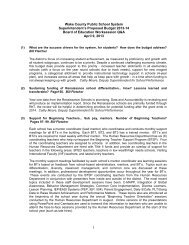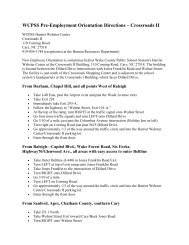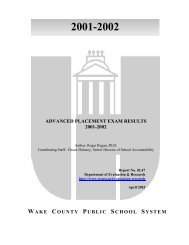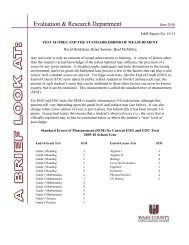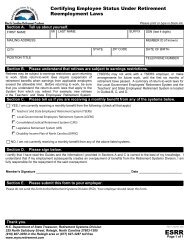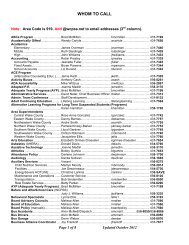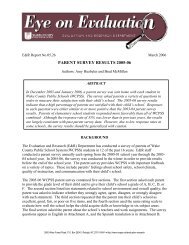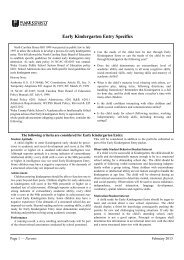2007-08 Adopted Plan - Wake County Public School System
2007-08 Adopted Plan - Wake County Public School System
2007-08 Adopted Plan - Wake County Public School System
You also want an ePaper? Increase the reach of your titles
YUMPU automatically turns print PDFs into web optimized ePapers that Google loves.
<strong>Wake</strong> <strong>County</strong> DemographicsThe population increase from 1990 to 2000 (when the last census wastaken) in <strong>Wake</strong> <strong>County</strong> is more than double the population increase inNorth Carolina as a whole. For the total population, there was a 21.4percent increase in North Carolina, while <strong>Wake</strong> <strong>County</strong> experienced a48.3 percent increase. This rate of increase seems to hold true for allraces in <strong>Wake</strong> <strong>County</strong> compared to the state. For instance, the whitepopulation in <strong>Wake</strong> <strong>County</strong> increased by 40.1 percent from 1990 to 2000,while the white population in North Carolina increased by 15.8 percent.Additionally, the black, or African American population increased by 40.9percent in <strong>Wake</strong> <strong>County</strong>, while the state’s African American populationonly increased 19.4 percent.HouseholdsIn 2000, there were 242,040 total households in <strong>Wake</strong> <strong>County</strong>. Thisfi gure increased to 293,580 in 2003. The median household income was$50,582 in 2003. According to the American Community Survey, by 2005the median household income was $57,284. The average householdsize has remained fairly consistent with 2.51 persons per household in2000, while the average family size was 3.06 persons. Families madeup 64 percent of the households in <strong>Wake</strong> <strong>County</strong>. Of the total numberof households, 65.6 percent were families (158,765), while 34.4 percentwere nonfamilies, or households where the householder is living alone(83,275). There were 127,114 married couple families, 23,755 femaleheaded families, and 3,677 male headed families with children, accordingto the 2000 US Census).Income and PovertyAccording to the 2000 Census Data, the average annual wage in <strong>Wake</strong><strong>County</strong> was $35,366 compared to the average annual wage in NorthCarolina of $31,072. The per capital income, which is defi ned as theaverage gross income per household, per 1,000 people, was $27,004in <strong>Wake</strong> <strong>County</strong> in 2000, but increased to $28,256 in 2003. In 2000,<strong>Wake</strong> <strong>County</strong> had 47,685 people living in poverty and a poverty rateof 7.8 percent. The child poverty rate in <strong>Wake</strong> <strong>County</strong> is 8.6 percent,while the elderly poverty rate is 9.9 percent. By 2005, the AmericanCommunity Survey estimated that 75,430, 10.3 percent, <strong>Wake</strong> <strong>County</strong>residents were in poverty.Housing and Housing CharacteristicsJust as <strong>Wake</strong> <strong>County</strong>’s population has grown tremendously over thelast 24 years, so has its housing supply. Between 1980 and 2000, theU.S. Census Bureau estimates that <strong>Wake</strong> <strong>County</strong> added more than145,000 housing units to its housing stock. In 2004, <strong>Wake</strong> <strong>County</strong> hadan estimated 303,473 units. As in the case of population growth, muchof this increase in the housing stock was driven by municipal growth.The biggest urban areas, Raleigh and Cary, added the most new units,but many of the smaller towns grew faster, particularly Holly Springs,Morrisville, Knightdale, and Apex.Between 1980 and 2005, <strong>Wake</strong> <strong>County</strong> added nearly 2,750 newsubdivisions covering more than 1<strong>08</strong>,000 acres of land. In fast growthyears, nearly 7,000 acres a year have been converted to new subdivisiondevelopment. Even in slow growth years, approximately 4,000 acres ayear have been used for new subdivisions.<strong>Wake</strong> <strong>County</strong> saw an increase in all three main categories of housing:single-family detached, multiple unit and manufactured housing.Between 1990 and 2004, <strong>Wake</strong> <strong>County</strong> added nearly 84,000 singlefamilydetached housing units to its housing stock. By 2004, 60 percentof all housing units were single-family detached compared to 56 percentin 1990. The greatest mix in housing types was in <strong>Wake</strong> <strong>County</strong>’s urbancore, and in several of these townships the housing stock was less than50 percent single-family detached units.Housing values in <strong>Wake</strong> county have been steadily increasing since theearly 1990s. From 1996-2005, average housing values in <strong>Wake</strong> <strong>County</strong>increased by approximately $53,000 and average sales prices by over$29,000. By 2005, the highest average residential property values werein Cary, Morrisville and in unincorporated <strong>Wake</strong> <strong>County</strong>. The lowest werein Wendell and Zebulon.The Housing Affordability Task Force Report indicates that between 1990and 1998 median household income in <strong>Wake</strong> <strong>County</strong> rose by 34 percent,apartment rents rose by 57 percent, and home prices rose by 52 percent.This disparity in the rate of growth between incomes and home pricesand rental costs confi rms that housing is becoming less affordable formany residents of <strong>Wake</strong> <strong>County</strong>.382




